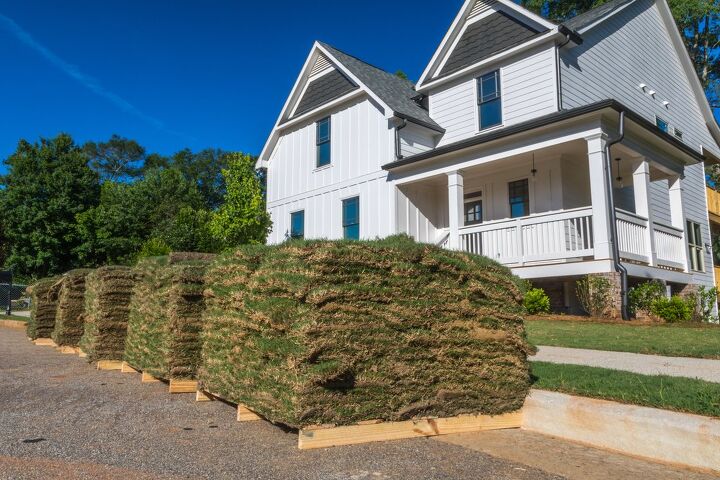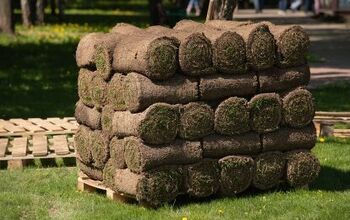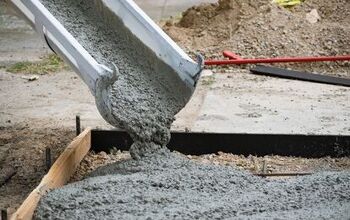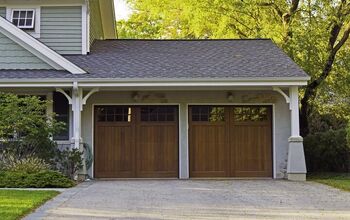How Many Square Feet Is A Pallet Of Sod? (Find Out Now!)

You’re taking a significant step toward finishing your landscape design. Buying sod by the pallet can get expensive. Plus, there are several things to consider. So, how many square feet are in a pallet of sod, and what does that mean for your budget? Here’s what you need to know.
The average pallet of sod is around 400 square feet. But some of them can get as large as 700 square feet. Meanwhile, the size of a sod pallet depends on several factors, including the type of grass it is. Also, the weight can change if the sod gets wet.
Do You Need Sod Installation Services?
Get free, zero-commitment quotes from pro contractors near you.

What Is a Pallet of Sod?
Sod is another word for grass. It’s a flat sheet of pre-cut grass that you can install directly into your lawn. Unlike planting seeds, sod produces a grassy lawn instantly. That’s why new construction commonly uses it where the land has been pulverized.
A pallet of sod is a massive chunk of several grass pieces. Meanwhile, pallets come in a wide variety of sizes. You can buy sod in bulk this way, saving time and money on home improvement projects. However, the cost and coverage often depend on which type of grass it is.
How Many Square Feet Are 2 Pallets of Sod?
Two pallets of sod are double what one pallet of sod is. So, if your pallet is 400 square feet, then two of them would be 800 square feet. These numbers may be off by a few feet, depending on the type of grass. The way a retailer sells its sod supply may change these measurements as well.
Be sure to discuss the details before buying anything. And double-check the pallet’s measurements while comparing that to the area you need to cover. Remember, you can always use a sod calculator if you need to find accurate numbers.
How Many Pieces of Sod Are In a Pallet?
Did you calculate the correct number of sod pieces or not? Better yet, how do you add it all up when you don’t have access to a calculator? Begin by considering the square footage of the pallet in question. Let’s say ours is 500 square feet.
If one piece of sod measures 16 inches by 24 inches, that means it’s 2.75 square feet in size. And if you take 500, then divide it by 2.75, you get approximately 181. So, a 500 square foot pallet of sod would most likely contain at least 180 pieces in it.
You can use that same formula to determine how many pieces are in bigger or smaller pallets. Just don’t forget to adjust the size of each piece. For example, if you had a 500 square foot pallet with 12-inch by 12-inch pieces, you’d divide 500 by that square footage instead.
How Do You Calculate Square Footage for Sod?
Sod is sold in two ways: by the piece and by the square yard. But it’s easier to figure out how many pieces you need when you can calculate square footage. So, get your thinking caps on because this involves a few steps:
#1. Determine the Length and Depth of Each Piece
Measure each side of the piece to find this number. Then write it down, so you don’t forget.
#2. Multiply Those Two Numbers Together
Combine the length and depth (width) to find the product. You should have a three-to-four digit number, which represents square feet.
#3. Divide the Square Footage By 9
Take the square footage and divide it by nine because that will give you the square yards.
If you need more help calculating the square footage of a pallet of sod, ask a professional. Usually, someone at the supplier will know how to find the numbers quickly. Or they’ll have a chart to help you figure it out on your own.
Can You Put New Sod on Top of Old Grass?
You might be trying to save time and money by placing sod over existing grass. In most cases, that’s perfectly fine. The sod will use the existing roots to obtain a better hold on the ground. However, there are a few things to consider before going this route.
For one, the new sod could kill your old grass for good. So, if the sod doesn’t take, you’ll be left with a bare yard. Plus, too much moisture on your lawn can cause the sod to wilt and mold. That means you have to be extra careful in the weeks following.
Always check with a professional gardener or landscaping engineer for more information. They’ll understand the pros and cons of laying sod over seeds and grass. And they can help you decide which type of grass to plant on your property as well.
Install Sod the Right Way
There’s a protocol to installing sod on your property. So, don’t ignore the rules. First, you have to level the area. Then, you must calculate the square footage of the site to buy enough green pieces. And if you have trouble getting it down or maintaining it, contact a professional.
Do You Need Sod Installation Services?
Get free, zero-commitment quotes from pro contractors near you.

Related Questions
How Many Inches of Top Soil Do I Need for Sod?
In most cases, you need at least four inches of healthy topsoil to install sod on your lawn. That amount may differ depending on which type of grass you choose. So, ask an expert for more specific details.
When Is the Best Time to Plant Sod?
You can realistically plant sod at any time during the planting season where you live. That’s usually from the early spring to the last fall. Just be sure there are cool enough temperatures with plenty of water to help the sod take root.
Can You Lay Sod on Uneven Ground?
Yes, you can install new sod pieces on unleveled ground. However, it may not appear uniform or professionally done. Plus, laying sod is a terrific excuse to get rid of dips and hills on your lawn. So, consider at least tilling the ground in that area.
Related Guides

Tiffany Nichols specializes in aesthetics, design, marketing, and manufacturing. She's a copywriter and editor for several home renovation companies in the U.S. and works alongside some of the biggest names in the industry. Her hobbies include architecture, art, mental health, and fashion.
More by Tiffany Nichols























![Cost To Drill A Well [Pricing Per Foot & Cost By State]](https://cdn-fastly.upgradedhome.com/media/2023/07/31/9074980/cost-to-drill-a-well-pricing-per-foot-cost-by-state.jpg?size=350x220)



